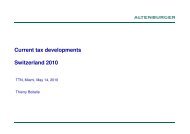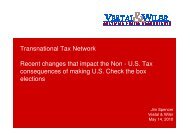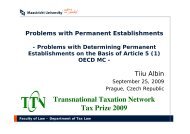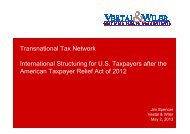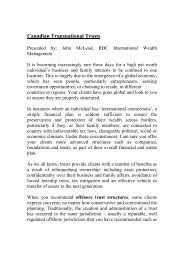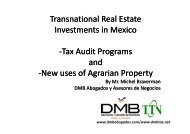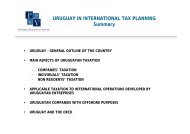Silvania Tognetti, Brazil, Pereira Neto, Galdino, Macedo Advogados ...
Silvania Tognetti, Brazil, Pereira Neto, Galdino, Macedo Advogados ...
Silvania Tognetti, Brazil, Pereira Neto, Galdino, Macedo Advogados ...
You also want an ePaper? Increase the reach of your titles
YUMPU automatically turns print PDFs into web optimized ePapers that Google loves.
<strong>Silvania</strong> <strong>Tognetti</strong><br />
November, 2011
GREAT MOMENT FOR BUSINESS<br />
In 2010, the country’s economy grew 7.5%, making it the<br />
seventh-largest in the world, according to the World<br />
Bank.<br />
In 2011, <strong>Brazil</strong>’s GDP is expected to grow 4.5%, lower<br />
than in 2010, but still a good result.<br />
In the next years with 2014 World Cup and 2016 Olympic<br />
Games that will attract huge investments in urban<br />
infrastructure.<br />
According to the United Nations Conference on Trade<br />
and Development, <strong>Brazil</strong> ranked fifth among all countries<br />
in foreign direct investment inflows in 2010
Challenges in <strong>Brazil</strong><br />
an incomprehensive and expensive tax system<br />
a highly complex labor environment<br />
burdensome bureaucracy<br />
High interest rate in credits transactions<br />
troublesome corruption in all areas and levels<br />
deep social imbalances with violence as result
But...<br />
...your company or your client will<br />
do business with or in <strong>Brazil</strong>,<br />
sooner or later!
Then, you should know three things about<br />
to invest in <strong>Brazil</strong>:<br />
It costs three times more<br />
It takes three times longer<br />
It makes three times more PROFIT!
And you would better know that...<br />
<strong>Brazil</strong>ian Interpretation for Article 7 of OECD Model<br />
Convention doesn’t include on it income for services<br />
rendered to <strong>Brazil</strong>ians residents.<br />
Tax on Financial Transaction in a “fictional outflow and<br />
inflow of funds”<br />
CFC rules in <strong>Brazil</strong> applies for all controlled or associated<br />
foreign company.<br />
Transfer Pricing rules in <strong>Brazil</strong> adopt fixed margins for all<br />
different types of business.
And you would better also know<br />
that...<br />
Thin capitalization in <strong>Brazil</strong> may turn expenses with<br />
interests non deductible.<br />
In order to calculate corporate taxes, the new <strong>Brazil</strong>ian<br />
GAP is not applicable, but the old <strong>Brazil</strong>ian GAP.<br />
There is a war among <strong>Brazil</strong>ian States: ICMS!<br />
The no cumulative system for payment of PIS and Cofins<br />
(Social Contributions on gross revenues) is a puzzle for<br />
everybody.
Article 7 OECD Model Convention: Services<br />
Payments made by <strong>Brazil</strong>ian residents to foreign services<br />
providers are subject to withholding income tax at 15% or<br />
25%.<br />
Taxes authorities interpret that Article 7 of Double<br />
Taxation Treaties doesn’t apply.<br />
Court decisions recognize application of Article 7.<br />
<strong>Brazil</strong> has no Double Taxation Treaty with Germany due to<br />
this type of special interpretation.<br />
French tax authorities deny tax credit calculated on<br />
income tax paid in <strong>Brazil</strong>.
Turning Debt into Equity<br />
In <strong>Brazil</strong>, inflow and outflow of funds are controlled by<br />
<strong>Brazil</strong>ian Central Bank.<br />
Tax on financial transactions (IOF) applies in exchange of<br />
currency.<br />
In order to attend exchange control rules, if a foreign<br />
lender decides to turn its credit into debtor equity,<br />
registration of outflow and inflow of funds is necessary,<br />
and a exchange agreement will be needed.<br />
Tax on financial transactions apply in this transaction.<br />
Recent thin capitalization rules X IOF
CFC Rules<br />
Article 74 of Provisional Measure 2,158-35/ 2001 provided<br />
that the income generated by a foreign controlled or<br />
associated company will be deemed available to the <strong>Brazil</strong>ian<br />
controlling or associated company as of the date of the<br />
balance sheet in which such amounts are reflected, for the<br />
purposes of calculating the bases for the Income Tax (IR) and<br />
the Social Contribution on Net Profit (CSLL).<br />
Note that it applies for all controlled or associated company.<br />
Constitutionality of Article 74 is under review by Supreme<br />
Court.<br />
Superior Court of Justice recognizes the legality of article 74,<br />
but there is recent decision in the sense that profit is not the<br />
equity value of controlled or associated company.
Margins in Transfer Pricing<br />
Unique in the world: aims to achieve the arm´s length<br />
standard by making use of a series of safe harbors and<br />
fixed formula.<br />
Taxpayer is faced with a tough practical reality: he would<br />
need to apply one price in order to fit into the <strong>Brazil</strong>ian<br />
transfer pricing standards, and another different price, in<br />
order to attend the OECD transfer pricing regulation.<br />
Certainty of <strong>Brazil</strong>ian system: development of an<br />
objective methodology to reduce risk of assessment.<br />
Safe harbors in exportation limit the number of taxpayers<br />
that must demonstrate Transfer Pricing accomplishment.
Margins in Transfer Pricing<br />
Transfer pricing adjustments in imports of assets, goods,<br />
services or rights: (i) Comparable Independent Prices (PIC); (ii)<br />
Resale Price less 20% Profit (PRL 20 - for goods imported and<br />
resold without undergoing any industrial process in <strong>Brazil</strong>); (iii)<br />
Resale Price Less 60% Profit (PRL 60 - for imported goods<br />
which undergo further industrialization in <strong>Brazil</strong>); (iv)<br />
Production Cost Plus Profit (CPL).<br />
If the taxpayer does not benefit from any safe harbor, any one<br />
of the following four methods can be used to calculate the<br />
benchmark for exports: (i) Export Sales Price (PVEX); (ii)<br />
Wholesale Price in Country of Destination Less Profit (PVA)<br />
15% profit margin; (iii) Retail Price in Country of Destination<br />
Less Profit (PVV) 30% retail margin; and (iv) Purchasing or<br />
Production Cost Plus Taxes and Profit (CAP) (15% margin).
Thin Capitalization<br />
Limits for deduction of interests from income tax basis (and also<br />
social contribution on profit). It is not a prohibition of thin<br />
capitalization.<br />
Applicable for related party loans from abroad (debt-equity ratio<br />
of 2 to 1) and for loans from companies located in tax haven<br />
jurisdictions or considered as privileged tax regimes (a<br />
debt/equity ratio of 0.3 to 1).<br />
The limitation still applies if the loan is taken from a non<br />
resident bank and the guarantor is related to the <strong>Brazil</strong>ian<br />
debtor.<br />
Beneficiaries located in tax havens or considered as privileged<br />
tax regimes: Interest payments made to beneficiaries in such<br />
circumstances are deductible only if the <strong>Brazil</strong>ian debtor is able<br />
to demonstrate some sort of substance evidences of the foreign<br />
lender
<strong>Brazil</strong>ian GAP: IFRS and Pre-IFRS<br />
Provisional measures established the RTT (Transitory Tax<br />
Regime) in 2009 in order to neutralize the impact of new<br />
IFRS accounting methods<br />
Pre-IFRS tax rules still apply to calculate main federal taxes<br />
on the basis of accounting rules in force until December<br />
2007 (when the transition from the former <strong>Brazil</strong> GAAP to<br />
IFRS began).<br />
It will continue until a new tax law that considers the<br />
current <strong>Brazil</strong> GAAP effects is issued.<br />
“Fcont” registers the differences between the two <strong>Brazil</strong>ian<br />
GAP.
States War: ICMS<br />
26 States have the power to enact their own ICMS law,<br />
collect it, interpret it and judge the taxpayers defenses on<br />
tax assessments.<br />
Tax incentive on ICMS depends on approval of all States<br />
(Confaz).<br />
When the tax incentive is unilaterally enacted by a certain<br />
State, the Supreme Court must review the constitutionality<br />
of the State Law.<br />
States decided to disregard tax credits on acquisition of<br />
goods from a company that is entitled to a tax incentive in<br />
one State that was not regularly approved by all States.
PIS and Cofins<br />
Pis and Cofins are social contributions on gross revenues.<br />
There are two regimes for PIS and Cofins: cumulative and<br />
non cumulative.<br />
There are also PIS and Cofins on importation of goods and<br />
services.<br />
In non cumulative regime, the taxpayer is allowed to offset<br />
credits of Pis and Cofins that were paid by its providers.<br />
However, definition of which goods or services allow the<br />
tax credit is very difficult.<br />
By a computer system, tax authorities aim to end disputes<br />
with taxpayers regarding these credits.
Obrigada!
<strong>Silvania</strong> <strong>Tognetti</strong><br />
SP +55 11 3638-7013<br />
RJ +55 11 3077-3912<br />
silvania.tognetti@bpgm.com.br<br />
Rua Olimpíadas 100 – 6º. andar<br />
São Paulo | SP | Brasil | CEP 04551-000<br />
Fax +55 11 3638-7040 / 7050<br />
http://www.bpgm.com.br




